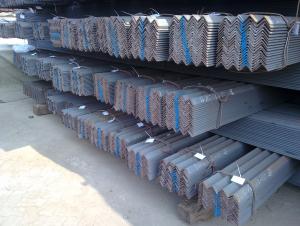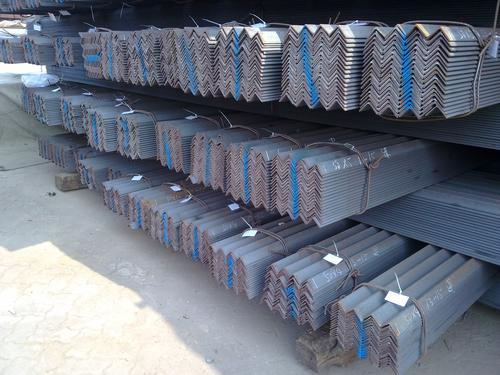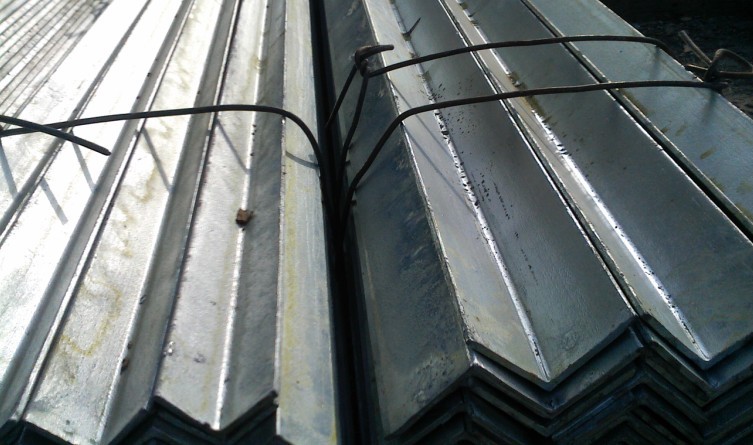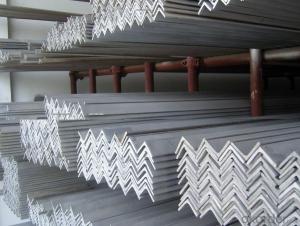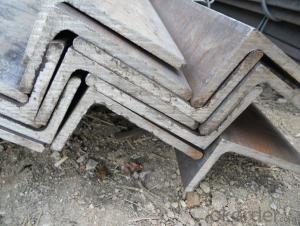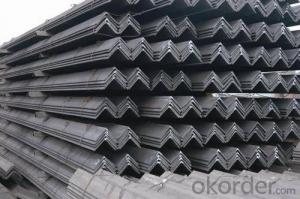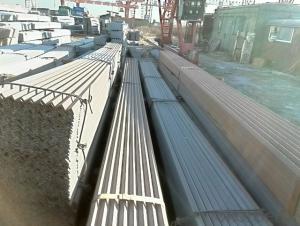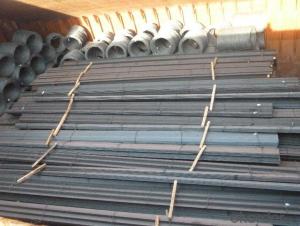Hot Rolled Structure High Quality Angle
- Loading Port:
- China Main Port
- Payment Terms:
- TT or LC
- Min Order Qty:
- -
- Supply Capability:
- -
OKorder Service Pledge
OKorder Financial Service
You Might Also Like
Product Description:
OKorder is offering high quality Angle Steel at great prices with worldwide shipping. Our supplier is a world-class manufacturer of steel, with our products utilized the world over. OKorder annually supplies products to European, North American and Asian markets. We provide quotations within 24 hours of receiving an inquiry and guarantee competitive prices.
Product Applications:
According to the needs of different structures, Angle can compose to different force support component, and also can be the connections between components. It is widely used in various building structures and engineering structures such as roof beams, bridges, transmission towers, hoisting machinery and transport machinery, ships, industrial furnaces, reaction tower, container frame and warehouse etc.
.
Product Advantages:
OKorder's Angle Steel are durable, strong, and resist corrosion.
Main Product Features:
· Premium quality
· Prompt delivery & seaworthy packing (30 days after receiving deposit)
· Corrosion resistance
· Can be recycled and reused
· Mill test certification
· Professional Service
· Competitive pricing
Product Specifications:
1.Grade: SS200,300,400 series
2.Size: 25×25×3 mm-100×100×10mm
3.Process: HRAP
4. Length: 2-6m
5. Shape: Equal
6. Delivery: within 20 days
7. MOQ: 1 ton
8. Certificate: ISO 9001:2008, SGS
9. Package:Standard Export Packing, or put into wooden boxes according to your requirement
10. Application: Construction, Marine, Industry and so on
Name | Stainless Steel Angles | ||||||
Standard | ASTM A554, A312, A249, A269 and A270 | ||||||
Material Grade | 304,316,201,202, 316L,430 | ||||||
Length | 6m or as customers' request | ||||||
Tolerance | a) thickness: +/-0. 15mm | ||||||
b) Length:+/-4. 5mm - 0mm | |||||||
Surface | 180G, 320G, 400G Satin / Hairline(Matt Finish, Brush, Dull Finish) 400G, 500G, 600G or 800G Mirror finish | ||||||
Application | Decoration construction, upholstery, industry instruments | ||||||
Test | Squash test, Extended test, Water pressure test, Crystal rot test, Heat treatment, NDT | ||||||
Chemical Composition of Material |
Composition
Material | 201 | 202 | 304 | 316L | 430 | |
C | ≤0.15 | ≤0.15 | ≤0.08 | ≤0.08 | ≤0.12 | ||
Si | ≤1.00 | ≤1.00 | ≤1.00 | ≤1.00 | ≤1.00 | ||
Mn | 5.5-7.5 | 7.5-10 | ≤2.00 | ≤2.00 | ≤1.00 | ||
P | ≤0.06 | ≤0.06 | ≤0.045 | ≤0.045 | ≤0.040 | ||
S | ≤0.03 | ≤0.03 | ≤0.030 | ≤0.030 | ≤0.030 | ||
Cr | 16-18 | 17-19 | 18-20 | 16-18 | 16-18 | ||
Ni | 3.5-5.5 | 4-6 | 8-10.5 | 10-14 | |||
Mo | 2.0-3.0 | ||||||
Mechanical Property | Material Item | 201 | 202 | 304 | 316L | ||
Tensile Strength | ≥535 | ≥520 | ≥520 | ≥520 | |||
Yield Strength | ≥245 | ≥205 | ≥205 | ≥205 | |||
Extension | ≥30% | ≥30% | ≥35% | ≥35% | |||
Hardness (HV) | <253 | <253 | <200 | <200 | |||
FAQ:
Q1: Why buy Materials & Equipment from OKorder.com?
A1: All products offered byOKorder.com are carefully selected from China's most reliable manufacturing enterprises. Through its ISO certifications, OKorder.com adheres to the highest standards and a commitment to supply chain safety and customer satisfaction.
Q2: How do we guarantee the quality of our products?
A2: We have established an advanced quality management system which conducts strict quality tests at every step, from raw materials to the final product. At the same time, we provide extensive follow-up service assurances as required.
Q3: How soon can we receive the product after purchase?
A3: Within three days of placing an order, we will begin production. The specific shipping date is dependent upon international and government factors, but is typically 7 to 10 workdays.
Images:
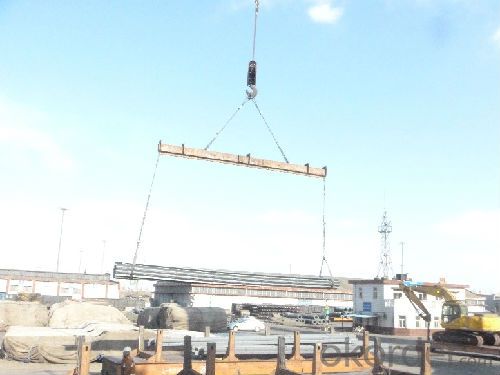
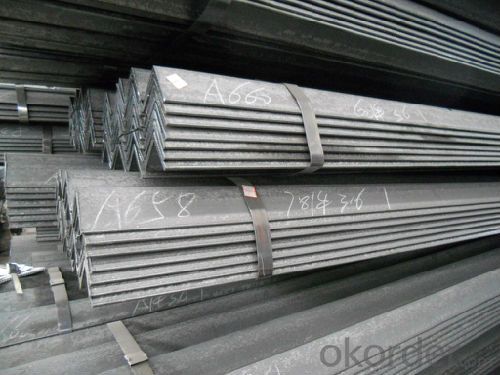
- Q: Can steel angles be used as supports for beams or columns?
- Yes, steel angles can be used as supports for beams or columns. Steel angles provide structural support and are commonly used in construction to provide stability and reinforcement for beams and columns. They are known for their strength and durability, making them suitable for bearing heavy loads and providing structural integrity to the overall structure.
- Q: How do you determine the torsional stiffness of a steel angle?
- To determine the torsional stiffness of a steel angle, you need to consider its geometry and material properties. First, you should calculate the polar moment of inertia (J) of the steel angle. The polar moment of inertia represents a shape's resistance to torsion and is calculated by summing the products of the differential area elements and their distances squared from the axis of rotation. For a steel angle, you can use standard formulas or reference tables to determine the polar moment of inertia. Next, you need to determine the material properties of the steel angle, specifically its modulus of rigidity (G). The modulus of rigidity measures a material's resistance to deformation under shear stress. This value is typically provided by the steel manufacturer or can be obtained from material property databases. Once you have calculated the polar moment of inertia and obtained the modulus of rigidity, you can determine the torsional stiffness (K) using the formula K = G * J. The torsional stiffness represents the ability of the steel angle to resist twisting or torsional deformation when subjected to a torque. It is important to note that the torsional stiffness of a steel angle can vary depending on factors such as the angle's size, shape, and the specific steel alloy used. Therefore, it is recommended to consult relevant design codes or engineering references to ensure accurate calculations and consider any additional factors that may affect the torsional stiffness.
- Q: Can steel angles be galvanized or coated for additional protection?
- Yes, steel angles can indeed be galvanized or coated for additional protection. Galvanizing is a common method used to protect steel from corrosion. It involves coating the steel with a layer of zinc, which acts as a barrier against moisture and other corrosive elements. This process can be done through hot-dip galvanizing, where the steel angle is immersed in a bath of molten zinc, or through electroplating, where a thin layer of zinc is applied to the surface of the steel through an electric current. Coating steel angles with other protective materials is also a viable option. There are various coating options available, such as epoxy, powder coatings, and paint. These coatings create a protective layer on the surface of the steel, shielding it from environmental factors that could lead to corrosion or damage. By galvanizing or coating steel angles, additional protection is provided, extending the lifespan of the material and ensuring its durability in different applications and environments.
- Q: What's the size of No. 5 angle iron?
- The specifications are expressed in millimeters of edge width * edge width * edge thickness. Such as "/ 30 x 30 x 3", that is 30 mm width equal angle, edge thickness of 3 mm. It is the number of available models, models of PCT wide edge, such as angle 3#. The model does not mean the size of the different edges and sizes of the same model. Therefore, the width, the edge and the thickness of the angle iron should be filled out in the contract and other documents, so as not to be indicated by the model alone.
- Q: Can steel angles be welded?
- Certainly, the welding of steel angles is possible. Welding serves as a widely employed technique for the fusion of steel angles. This entails subjecting the steel angles to elevated temperatures while simultaneously administering a filler substance, commonly in the shape of a welding rod or wire, to foster a robust connection between the angles. Through welding, an enduring and reliable linkage is established between steel angles, rendering it applicable for a multitude of purposes in construction, manufacturing, and diverse industrial sectors.
- Q: What are the dimensions of a standard steel angle?
- The dimensions of a standard steel angle typically include the length of the legs and the thickness of the steel.
- Q: Can steel angles be used for electrical conduits?
- Steel angles cannot serve as electrical conduits. Electrical conduits are commonly made from non-metallic materials like PVC or metal materials such as galvanized steel or aluminum. Steel angles, on the other hand, are utilized for structural support and reinforcement in construction endeavors, but they are not intended or appropriate for use as electrical conduits. Electrical conduits have specific insulation, protection, and grounding requirements that steel angles do not fulfill. To ensure the integrity and efficiency of electrical installations, it is crucial to employ appropriate electrical conduits that satisfy the necessary safety standards.
- Q: How are steel angles protected against corrosion?
- There are various techniques available to protect steel angles from corrosion. One commonly used method entails applying a protective coating. This can be accomplished by either painting the steel angles with a paint that resists corrosion or by employing galvanization, which involves immersing the steel angles in molten zinc to create a protective layer on the surface. Another approach to prevent corrosion in steel angles is the application of a corrosion inhibitor. This involves introducing chemicals or compounds to the steel angles that impede or decelerate the corrosion process. Additionally, conducting regular inspections and performing proper maintenance can aid in detecting and addressing any indications of corrosion before they result in significant damage.
- Q: Can steel angles be used in conveyor systems?
- Conveyor systems can indeed utilize steel angles. These angles are frequently employed in conveyor systems to provide stability and structural support. They can be employed to establish the framework for the conveyor system, encompassing the conveyor bed, side frames, and supports. Steel angles are renowned for their durability and strength, making them an optimal choice for handling hefty loads and enduring the continual movement and impact encountered by conveyor systems. Furthermore, steel angles can be easily joined through welding or bolting, enabling flexibility in designing and customizing conveyor systems to meet specific requirements. In summary, steel angles are a sought-after option in conveyor system construction due to their dependability, adaptability, and cost-effectiveness.
- Q: Can steel angles be used as supports for mechanical or HVAC ducts?
- Yes, steel angles can be used as supports for mechanical or HVAC ducts. Steel angles provide a strong and durable framework to securely hold and provide stability to the ductwork.
Send your message to us
Hot Rolled Structure High Quality Angle
- Loading Port:
- China Main Port
- Payment Terms:
- TT or LC
- Min Order Qty:
- -
- Supply Capability:
- -
OKorder Service Pledge
OKorder Financial Service
Similar products
Hot products
Hot Searches
Related keywords
